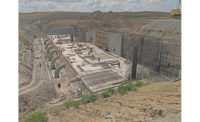Contracts frequently have conflicting sections.
This point became clear to Walter Shanly, a civil engineer from Canada, who finally pierced the Hoosac Mountain in western Massachusetts on Thanksgiving Day, 1873, in an age when tunneling was accomplished by the strength of strong arms swinging sledgehammers.
The hammers met against steel drills held by a “shaker,” who rotated the steel after each blow. Black powder was the only blasting agent. Work dragged on slowly this way from the early 1850s until Shanly signed a construction contract with the commonwealth of Massachusetts in December 1868 to complete the 5-mile railroad tunnel through the mountain. The job saw early examples of tunnel-boring machines, which failed at that time, as well as the dawn of nitroglycerin, which proved to be far more successful.
|
|
| SCHEXNAYDER |
Prior to the Shanly contract, two different contractors had attempted to bore the Hoosac Mountain for the Troy and Greenfield Railroad. Because the effort was being financed with commonwealth bonds, Massachusetts in 1862 foreclosed on the railroad company and took control of the work. Six and a half years of commonwealth direction still did not yield the desired progress, so on the advice of consulting engineer Benjamin H. Latrobe, Massachusetts let the work to Shanly.
Latrobe prepared the tender documents for the commonwealth, and these required the bidders to price the quantities stated in the tender documents—a unit-price contract. In the case of a contract made under this type of tender, the builder would be paid according to measured units of work actually performed; therefore, the cost to the commonwealth would not be fixed.
However, the legislative act of 1868 authorized one contract for completion of the Troy and Greenfield Railroad and the Hoosac Tunnel. So, during the final discussion with Gov. Alexander Bullock, it was suggested the contractor should take the contract for a lump sum—the contractor would be paid a fixed amount for the project no matter the actual amount of work performed.
In December 1868, when Shanly was asked if he “would accept the engineers’ measurements” and take the contract for a single fixed amount, he at once assented, “provided the engineers, Messrs. Latrobe and Frost, then present would assure [him] that the quantities had been carefully and accurately ascertained.”
Conflicting Words
Bad ground existed at the west end of the tunnel, and the negotiated contract specified brick arching for 1,270 ft. It also specified an amount of bricks not to exceed 4.5 million. The specifications for the eastern section were different, with the following language: “As the rock is sufficiently hard to prevent apprehensions from falls and slides, estimates will be made only of quantities within the exterior line prescribed for the Tunnel.”
The Hoosac Tunnel reached a milestone on Saturday, July 6, 1872: Shanly finished the construction of the brick arching for the distance required by the contract specifications. Several members of the Massachusetts legislature attended the ceremonial laying of the last brick. Then, in July 1873, the engineer for the commonwealth directed Shanly to perform additional arching in both the east and west sections of the tunnel.







